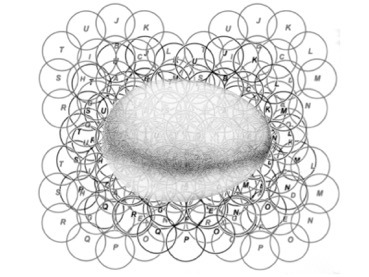An Egg as New Media: Holographic Entry Points of Learning
ニューメディアとしての卵:学習へのホログラム的な入口
Confusion and possibility: With the exponential growth of what we can know it is not clear what is worth paying attention to, much less learning. But to what extent are our decisions to pay attention and to learn determined by informational content, or by the particular form that the information takes? There is abundant research showing how particular forms of media affect how ideas are communicated and understood; indeed, some go so far as to claim that “the medium is the message.”*1 However, what media (mediums) count as relevant in our media ecology is largely unquestioned. Blogs, radios, smart phones, TVs, and traditional forms like books certainly count as mediums, but I would argue that we view the activity of a medium as fundamentally passive―simply the physical substrate to convey the encoded and immaterial information that contains the real meaning. This traditional understanding of media is an extension of the Cartesian mind/body dualism dominant in western philosophy: physical forms are means, but never meaning―the medium is essentially a form waiting to be filled with content.
But what if we considered objects such as an egg, an apple, or a hammer as forms of media as well? By this, I do not mean that an egg, an apple, or a hammer functions as a symbol for an idea―this would simply replicate the view of cultural meaning being carried upon a material medium. Instead, I am suggesting that the meaning embodied in an object is about the object itself, although in an expanded sense. For example, when cracking an egg into a frying pan there is a possibility, in that moment, to do more than just cook it. There is the opportunity to consider where the egg came from―the store, the farm, as well as the mother hen. Was she a caged hen, or one that was allowed to roam free? Were her feathers brown or white? What was she eating that made the color of the yolk congealing in the pan so orange? If we can imagine what new chicken that single egg might have become (given a different history) then we might also consider the ancient dinosaurs from which chickens and their eggs evolved over the past 65 million years.

Through this view, the egg is a medium in a different sense―it is a medium of its own existence as well as for the ecology of other objects, activities, histories, and possibilities that connect the matrix of mental and material associations that it (the egg) can evoke. This conception of media and its ecology locates a medium’s meaningfulness (meaning fullness) within its power to provoke deeper interpretation and critical imagination, not merely its ability to deliver packets of information. In terms of knowledge and learning, the shift in priorities is away from the acquisition of data and back towards the cultivation of deeper, holistic understanding.
We might call the egg-as-medium some kind of “holographic entry point.” I borrow this term from philosopher Thomas Kasulis’ description of the role that torii(鳥居)and shimenawa(しめ縄)play in within Shinto practice to designate objects and sites connecting humans to the larger totality of nature.*2 Typically we think of parts as connecting to make a whole; in turn, the whole can be broken down and reduced into its distinct parts. Kasulis argues that what makes an object or site “holographic,” is its ability to help us to understand that every part also contains the whole. The object or site as a medium doesn’t convey any one piece of data, instead it embodies meaning itself. Rather than thinking of messages, media, people, and objects as externally related to each other, the holographic perspective understands them as internally and inextricably related―a whole in every part, form as context for its own content.
This approach doesn’t mean that traditional notions of media should be completely rejected, however it does invite the possibility of picking up a smartphone and at the same time recognizing that we are picking up nuclear-powered electricity stored in Peruvian-sourced lithium that then flows through Shenzhen-crafted integrated circuits housed in a metal case whose aluminum was mined by hand in Brazil. It suggests an expansive and holistic alternative to a media philosophy that is currently so focused on filtering and reduction into informational parts. As low-tech as it is high-minded, the holographic view calls for a new media ecology of learning about things and with things, not simply through them.
Footnotes:
*1 McLuhan, Marshall. Understanding Media: The Extensions of Man. Mentor: New York.1964.
*2 Kasulis, Thomas P. Shinto: The Way Home. University of Hawaii Press: Honolulu. 2004.
